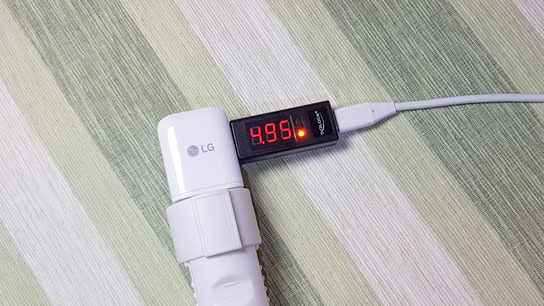I needed a USB Type-C multimeter to test a couple of under-performing USB Type-C ports, and to gather some data for another review I’ve been working on. I ended up with a cheap model from German manufacturer Delock, and here’s what I think about it.
To figure out how fast a device is charging, you need to know both the voltage (V) and current (A). Historically, classic USB Type-A ports would always provide 5 volt. The USB Power Delivery (USB-PD) specification has since added the ability to let devices negotiate higher voltages.
I haven’t got access to the proper testing equipment required to fully evaluate the capabilities of this USB Type-C multimeter. However, if you’re considering getting a USB multimeter, you’ll still find useful information in this review.
The Delock volt- and ampere meter for USB Type-C is an inexpensive option for measuring a current of up to 6 ampere at up to 24 volt. That means it should theoretically support up to 144 watts (W), though no maximum power is specified (and the USB-PD standard stops at 100 W). I’ve reached out to Delock for a clarification, and will update this review when I get a reply. For reference, a current model Apple MacBook Pro chargers that use Type-C connectors delivers either 61 W or 87 W.
Unidirectional measurements only
The male Type-C connector is quite chunky. It collides with my computer’s chassis and other cables when plugged in to my mainboard. I also can’t connect it to my Nexus 5X without removing its protective rubber bumper. I’ve looked at a few other multimeter alternatives, and all but one other model feature an elongated and slimmer design. I undervalued the benefits of these designs when I chose the Delock voltage- and amperage meter.
The male connector must be connected at the end providing the power source. Unlike every other design for a power multimeter for USB-C, the Delock isn’t bidirectional. This doesn’t matter much if you only intend to test Type-C cables. However, it does mean the multimeter can’t be used to measure a male Type-A to male Type-C cable. A female Type-C to female Type-C adapter can be used to work around this limitation, but this may introduce additional resistance and be a source of error in your testing.
Notably, I couldn’t find any other USB Type-C multimeters that are unidirectional like the Delock model. It seems to be a unique feature to not support bidirectional measurements. Which is extra interesting for Type-C cables, as one of their better features is that I can reverse the flow of power and charge my laptop battery from my phone – or the other way around at my choosing.
There should at least have been a switch for changing the measurement direction, even if it didn’t support bidirectional measurements.
Reading measurements
The screen of the Delock switches every second between displaying either ampere or voltage. The current unit is indicated by lighting up a LED behind either the ampere or voltage indicators (A on top and V below). As an aside, these indicators look a lot like stepper buttons.

A frustrating detail about this design is that it’s hard to read when upside down. An upside down A looks like a V and vice versa. Because of the layout of my computer setup, I’ve spent more time reading the display upside down than in the correct orientation.
The multimeter works instantly as soon as you connect a power source on the male port. As mentioned already, it’s not bidirectional. If you don’t provide power on the male port, the display will still show the correct voltage but not the current, and power will still go through the cable.
As for the accuracy of the measurements, I can’t tell for sure. What I can say, however, is in my testing I am seeing the expected results from my various USB Type-C chargers, ports, and other devices.
Alternatives
There’s a huge selection of Type-A multimeters on the market. As USB Type-C is relatively new, your choice in multimeters is somewhat more limited. Here are two [better?] alternatives to the Delock USB-C multimeter.
The Pluggable USB-C Voltage and Amperage Meter supports voltages between 4 and 20 V, and current up to 10 A. It should theoretically support 200 W, which is double that of the current USB Power Delivery specification. It supports bidirectional measurements and even features a direction indicator and a proper OLED display. The design is similar to the Delock multimeter, but is possibly a better option as its not unidirectional.
Another popular option is the Satechi Type-C Power Meter. This is the most sold USB-C multimeter on Amazon.com. This is the only multimeter I’ve found that specifies its maximum load (64 W). This is lower than the 100 W maximum of the USB-PD standard, and 32 % of what you’d expect, given that it specifies the same 4–20 V at 10 A operation range as the Pluggable USB-C multimeter.
It could very well be that Satechi is just more open about their product’s limitations. It supports bidirectional measurements and also tracks milliampere per hour, which seems to be a useful and unique feature. This multimeter is encased in a sleek aluminum body rather than cheap black plastic like the two other multimeteres.
Conclusion
There isn’t anything wrong with the Delock model other than its unidirectionality. Get yourself a bidirectional multimeter instead as this will be more flexible and let you test more types of devices and cables.
I would not buy this product again and I don’t recommend you do it either. Have a look at one of the alternatives mentioned above instead.
